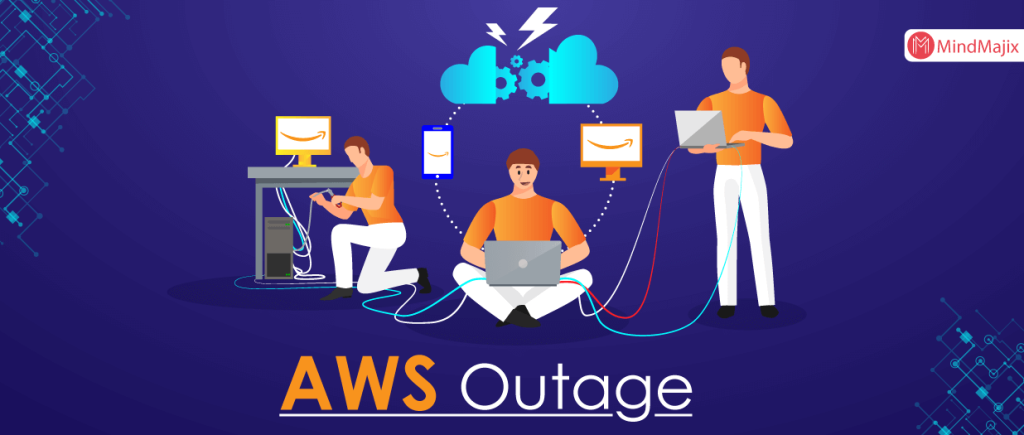Amazon Web Services (AWS) is the backbone of the modern internet, powering everything from social media platforms to critical financial systems. On October 20, 2025, AWS experienced one of its most significant outages in recent history, impacting millions of users globally. This incident highlights the importance of understanding what to do when AWS goes down and how businesses and individuals can mitigate the effects.
In this article, we’ll explore the causes of the AWS outage, its widespread impact, and practical steps to take during such events. Whether you’re a business owner, developer, or everyday user, this guide will help you navigate disruptions and minimize downtime.
Understanding the AWS Outage
The Timeline of the Outage
The AWS outage on October 20, 2025, began late on October 19 in the US East (N. Virginia) region (us-east-1), AWS’s largest and most critical data center. It lasted approximately 16 hours and affected over 140 services, creating a cascading effect that impacted global operations.
Key events during the outage included:
- 11:49 PM (Oct 19): Increased error rates and latencies detected across multiple AWS services.
- 12:26 AM (Oct 20): DNS resolution failures for DynamoDB API endpoints were identified.
- 2:24 AM: DynamoDB DNS issue resolved, but EC2 launch impairments and NLB health check failures emerged.
- 8:43 AM: Root cause identified as impairment in EC2’s internal subsystem for NLB health monitoring.
- 3:53 PM: AWS declared the outage resolved.
This event was caused by a DNS resolution failure affecting DynamoDB, which acted as a critical “control plane” for many AWS features. The outage triggered a cascade of issues, including EC2 instance launch failures and network connectivity problems.
The Impact of the Outage

Affected Services and Users
Over 142 AWS services were impacted, primarily those reliant on DynamoDB, EC2, or us-east-1 endpoints. Core categories included:
- Database & Storage: DynamoDB, RDS, Redshift, SQS
- Compute & Orchestration: EC2, Lambda, ECS, EKS, Glue
- Networking & Load Balancing: Network Load Balancer, API Gateway
- Monitoring & Management: CloudWatch, CloudTrail, IAM, AWS Config
High-profile examples of affected services include:
- Social & Media: Snapchat, Reddit, Twitch
- Gaming: Roblox, Fortnite
- Finance & Payments: Venmo, Lloyds Bank, HMRC
- Retail & E-commerce: Amazon, Delta, United Airlines
- Other: Alexa, Twilio
The outage disrupted ~1/3 of internet-dependent applications, affecting an estimated 100+ million users worldwide. Economic estimates peg losses at $500 million+, with a 300% spike in cybersecurity scans as users panicked.
What to Do When AWS Is Down

Immediate Actions
When AWS experiences an outage, it’s essential to act quickly to minimize disruption. Here are some immediate steps you can take:
- Check the AWS Status Page
-
AWS provides real-time updates through its status page. Check this first to confirm the outage and get details on affected regions and services.
-
Verify if Your Services Are Affected
-
If your application or service relies on AWS, determine whether it’s impacted. Look for error messages, failed requests, or connectivity issues.
-
Contact AWS Support
-
If your service is affected, reach out to AWS support for assistance. They can provide insights into the issue and guidance on mitigating its impact.
-
Review Your Backup Systems
-
Ensure that your backup systems are operational and ready to take over in case of a failure. This includes having redundant infrastructure and failover mechanisms in place.
-
Communicate with Stakeholders
- If your business is affected, inform your customers, partners, and internal teams about the situation. Transparency helps manage expectations and maintain trust.
Long-Term Strategies

While immediate actions can help during an outage, long-term strategies are crucial for minimizing future disruptions. Consider the following:
- Distribute Resources Across Multiple Regions
-
Avoid relying solely on a single region. Distribute your resources across multiple AWS regions to reduce the risk of a single point of failure.
-
Implement Auto Scaling and Load Balancing
-
Use AWS Auto Scaling and load balancing to handle traffic spikes and ensure your services remain available during high demand.
-
Use Caching and Quotas
-
Implement caching mechanisms to reduce the load on your services and use service quotas to prevent overloading during peak times.
-
Regularly Test Your Disaster Recovery Plan
-
Conduct regular tests of your disaster recovery plan to ensure it works effectively when needed. This includes simulating outages and verifying that backups and failover systems function correctly.
-
Monitor and Analyze Performance
- Use AWS CloudWatch and other monitoring tools to track the performance of your services. Analyze logs and metrics to identify potential issues before they escalate.
Lessons Learned from the AWS Outage

Key Takeaways
The AWS outage on October 20, 2025, offers valuable lessons for businesses and developers:
- Centralization of Critical Infrastructure
-
The outage highlighted the risks of centralizing critical infrastructure. While AWS is a leader in cloud computing, its dominance means that a single failure can have widespread consequences.
-
Need for Better Redundancy
-
The incident underscores the need for better redundancy in control planes. Businesses should consider diversifying their cloud providers and implementing robust failover mechanisms.
-
Importance of AI-Driven Anomaly Detection
-
AWS emphasized the need for AI-driven anomaly detection to identify and address issues more quickly. Investing in intelligent monitoring systems can help detect problems before they escalate.
-
User Education and Communication
-
Clear communication with users and stakeholders is essential during outages. Providing timely updates and transparent information can help manage expectations and maintain trust.
-
Continuous Improvement and Learning
- AWS committed to a full root cause analysis (RCA) for customers, emphasizing that such events, while rare, reveal scaling challenges at hyperscale. Continuous learning and improvement are vital for maintaining reliability.
Conclusion
The AWS outage on October 20, 2025, serves as a stark reminder of the internet’s dependence on a few key providers. While AWS is a leader in cloud computing, its outage demonstrated the vulnerabilities that come with centralized infrastructure. For businesses and individuals, the best approach is to be prepared, stay informed, and implement strategies that minimize the impact of such events.
By taking immediate actions and adopting long-term strategies, you can protect your services and maintain continuity even during unexpected outages. As the internet continues to evolve, so too must our approaches to managing and mitigating disruptions.
Stay updated with the latest news and developments in the tech world. Follow us for more insights on navigating the digital landscape.
Meta Title: US Trending News: What to Do When AWS Is Down
Meta Description: Learn how to respond when Amazon Web Services goes down. Discover actionable steps and long-term strategies to minimize downtime and keep your services running smoothly.
Author: [Name]
Title/Role: [Job Title or Expertise]
Credentials: [Summary of qualifications or experience related to the topic]
Profile Link: [Optional link to author profile]
Sources:
– AWS Official Post-Mortem Report
– Northeastern University Cybersecurity Insights
– DownDetector Outage Tracking
Internal Links:
– How to Monitor AWS Performance
– Best Practices for Cloud Resilience
– Understanding DNS Failures
Schema Markup:
{
"@context": "https://schema.org",
"@type": "Article",
"headline": "What to Do When Amazon Web Services Is Down: A Complete Guide",
"description": "Learn how to respond when Amazon Web Services goes down. Discover actionable steps and long-term strategies to minimize downtime and keep your services running smoothly.",
"author": {
"@type": "Person",
"name": "[Name]"
},
"datePublished": "2025-10-21",
"dateModified": "2025-10-21"
}
Featured Snippet Optimization:
When AWS is down, check the AWS status page, verify if your services are affected, contact AWS support, review your backup systems, and communicate with stakeholders.
CTA:
Stay updated with the latest news and developments in the tech world. Follow us for more insights on navigating the digital landscape.











More Stories
How to Claim Your Joy in League of Legends: A Step-by-Step Guide
What is WSET? A Comprehensive Guide to Wine Education
How Will VA Compensation Be Affected by a Government Shutdown?